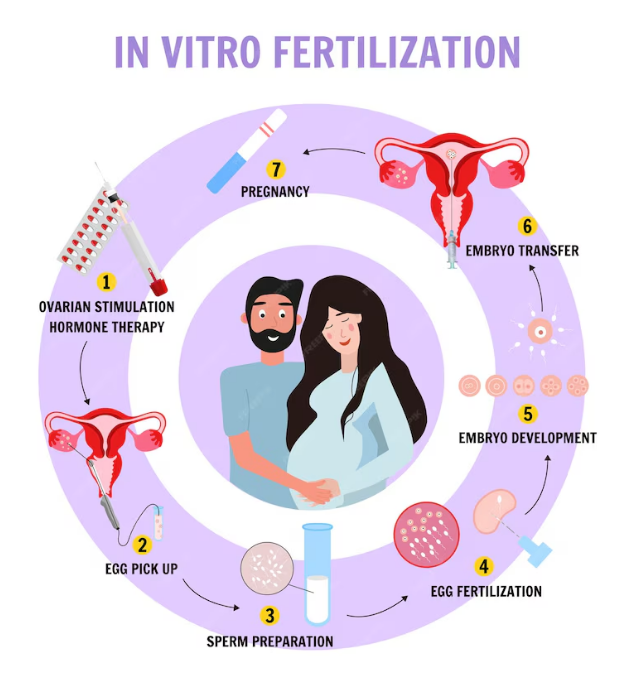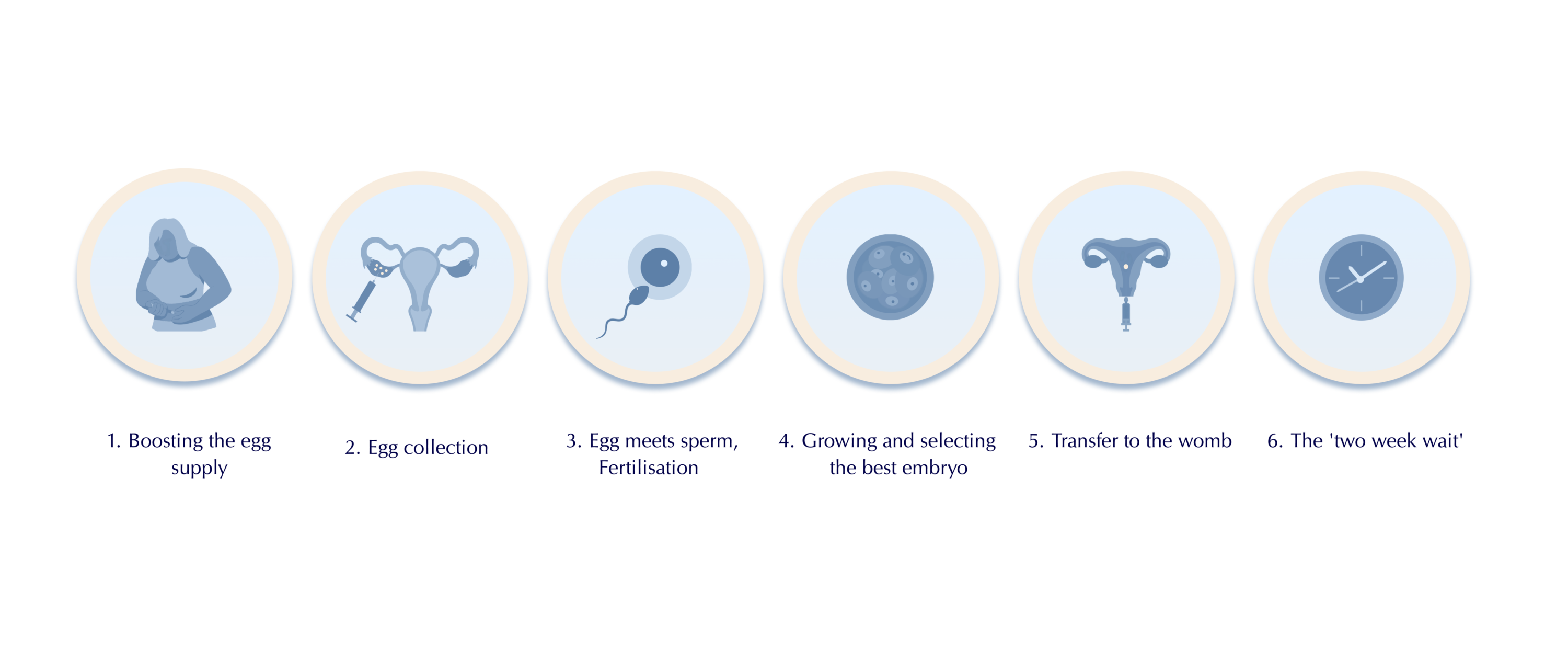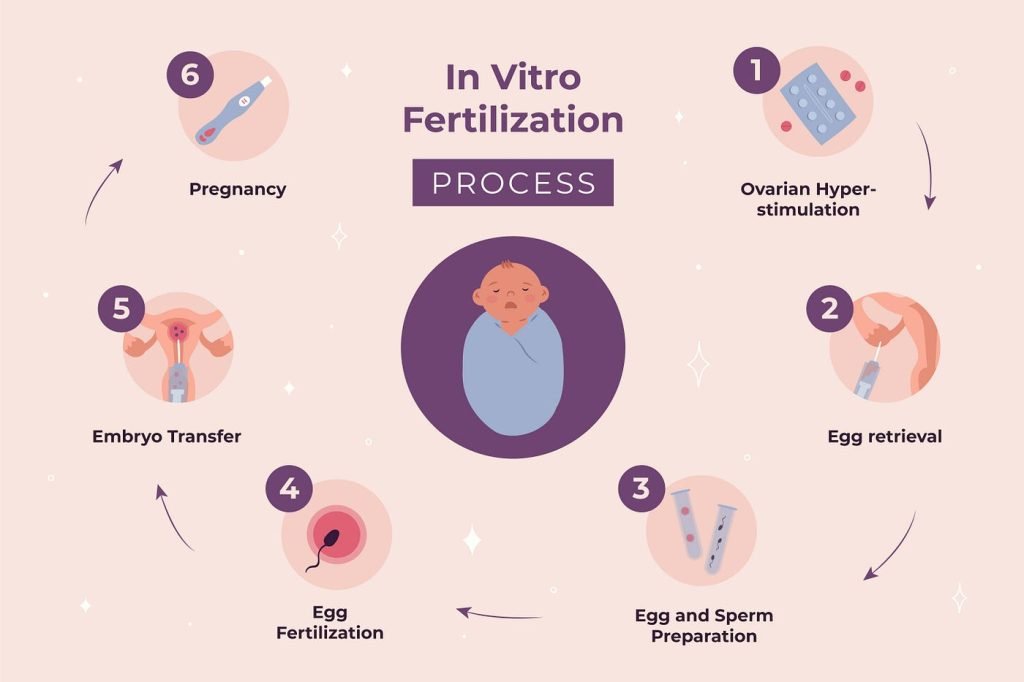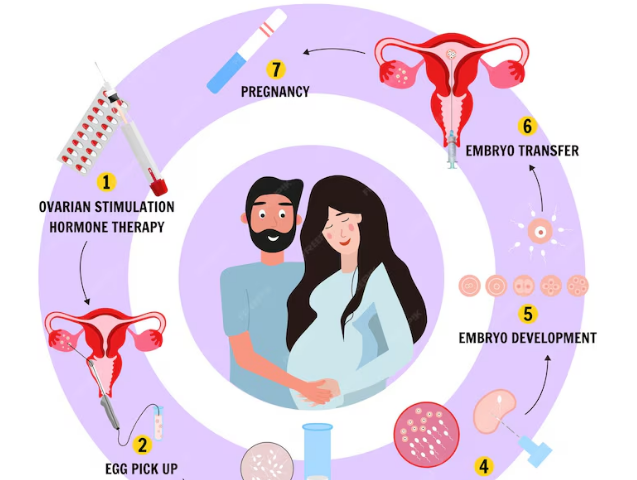
How Much Does IVF Cost? Your Complete Guide to Understanding In Vitro Fertilization Expenses
March 25, 2025The IVF Process Unveiled: Your Step-by-Step Guide to Starting a Family
Welcome to the wild, wonderful, and sometimes overwhelming world of in vitro fertilization (IVF)! If you’re here, you’re probably curious about what IVF really involves—beyond the basic “egg meets sperm in a lab” explanation. Maybe you’re thinking about it for yourself, or maybe you’re just fascinated by the science of making babies in a way that feels straight out of a sci-fi movie. Either way, you’re in for a ride! This article is your all-access pass to the IVF process, packed with details you won’t find in a quick Google search—think insider secrets, surprising facts, and practical tips to help you feel ready for this journey.
We’ll break it all down into bite-sized pieces, from the emotional rollercoaster to the tiny needles (yes, there are needles), and even the latest research that’s changing the game. Whether you’re a planner who loves checklists or someone who just wants the real scoop, we’ve got you covered. Let’s dive in!
What Is IVF, Anyway?
IVF stands for in vitro fertilization, which is Latin for “fertilization in glass.” Cool, right? It’s a process where doctors take eggs and sperm, mix them together in a lab, and then place the resulting embryo into a uterus to (hopefully) grow into a baby. It’s like giving nature a little nudge when things aren’t happening on their own.
But here’s something most people don’t know: IVF isn’t just for couples who can’t conceive naturally. It’s also used by single folks, same-sex couples, and even people who want to screen for genetic conditions before pregnancy. In 2023 alone, over 500,000 babies worldwide were born thanks to IVF—that’s about 2% of all births in the U.S.! It’s not a rare thing anymore; it’s a lifeline for millions.
Why People Choose IVF
- Infertility Struggles: Blocked tubes, low sperm count, or unexplained issues can make natural conception tricky.
- Dreams of Parenthood: Single people or LGBTQ+ couples often turn to IVF with donor eggs or sperm.
- Genetic Screening: Want to avoid passing on a family condition? IVF can help with that.
- Age Factor: As women get older, egg quality drops—IVF can use younger donor eggs to boost chances.
Fun Fact
Did you know the first IVF baby, Louise Brown, was born in 1978? She’s not even 50 yet, and now she’s a mom herself—conceived naturally! IVF has come a long way since then, and we’re here to spill all the tea on how it works today.
Step 1: Getting Ready—More Than Just Paperwork
Before the lab magic happens, there’s a prep phase that’s all about you. Think of it like training for a big game—except instead of running laps, you’re tweaking your body to produce eggs like a champ.
The Emotional Prep
Most articles skip this, but let’s be real: IVF can feel like an emotional marathon. You’re excited, nervous, and maybe even a little scared. One minute you’re dreaming of baby names (Luna? Liam?), and the next you’re wondering if you’ll ever get there. That’s normal! Studies show about 40% of people going through IVF feel some anxiety or stress. The trick? Talk it out—whether with a partner, friend, or therapist.
Tip: Keep a journal. Scribble down your hopes, fears, or even doodle a baby onesie. It’s a small way to process the big feelings.
The Physical Prep
Doctors need to check you out first—blood tests, ultrasounds, and maybe even a peek at your partner’s sperm (if applicable). They’re looking at hormone levels, ovarian reserve (how many eggs you’ve got left), and uterine health. Here’s where it gets personal: they might ask about your caffeine habits, late-night Netflix binges, or if you’re a gym rat. Why? Because lifestyle tweaks can make a difference.
- ✔️ Do: Eat colorful fruits and veggies—antioxidants help egg quality.
- ❌ Don’t: Overdo the coffee. More than 200 mg a day (about two cups) might lower success rates, says a 2022 study.
Insider Secret
Some clinics suggest acupuncture before IVF. It’s not just woo-woo stuff—research from 2021 found it could boost blood flow to the ovaries, potentially upping your egg count. Worth a try if you’re into needles anyway!
Step 2: Supercharging Your Ovaries
Now, the fun begins: ovarian stimulation. Normally, your body releases one egg a month. With IVF, doctors want a whole squad—think 10-15 eggs—to increase your odds. How? Hormones, baby!
How It Works
You’ll get daily shots (yep, tiny needles in your belly or thigh) for about 8-14 days. These meds—like FSH (follicle-stimulating hormone)—tell your ovaries, “Hey, let’s make more eggs!” You’ll visit the clinic a lot for ultrasounds and blood tests to see how those eggs are growing.
- What It Feels Like: A little bloating, maybe some mood swings. One patient described it as “PMS on steroids.”
- Weird Bonus: You might feel oddly proud watching your follicles (egg sacs) grow on the ultrasound screen. It’s like your own reality show!
Practical Advice
- Shot Hacks: Ice the spot first to numb it. Have your partner or a friend help—it’s less awkward than you’d think.
- Schedule It: Pick a consistent time each day, like after dinner, so it becomes routine.
Science Says
A 2023 study found that women under 35 typically produce 12-15 eggs per cycle, while over 40 might get 5-8. More eggs don’t always mean better chances, though—quality matters too.
Step 3: Egg Retrieval—Showtime!
Once your eggs are ready (about the size of a grape), it’s time to snag them. This is called egg retrieval, and it’s a quick procedure—about 20-30 minutes.
What Happens
You’ll be sedated (no pain, just a nap), and the doctor uses a thin needle guided by ultrasound to scoop out the eggs from your ovaries. It’s all done through the vagina—no cuts or stitches.
- Fun Fact: The average haul is 8-15 eggs, but some folks get 20+! One woman in 2022 set a personal record with 34—talk about an overachiever.
- Aftermath: You might feel crampy or spot a little blood. Rest up with a heating pad and your favorite show.
Real Talk
Egg retrieval sounds scarier than it is. “I was terrified I’d feel everything,” said Sarah, a 32-year-old IVF mom. “But I woke up, ate a cookie, and felt fine!” Most people are back to normal in a day or two.
Tip: Wear comfy pants—no tight jeans. Your ovaries deserve a break!
Step 4: Sperm Meets Egg—The Lab Love Story
While you’re chilling post-retrieval, the lab crew gets busy. This is where the “in vitro” part happens—outside your body, in a petri dish.
The Process
- Sperm Prep: If it’s your partner’s sperm, they’ll provide a sample that day (yes, in a little room with awkward magazines). If it’s donor sperm, it’s thawed out.
- Fertilization: Two ways to do it:
- Classic IVF: Sperm and eggs are mixed together and left to “find each other.”
- ICSI (Intracytoplasmic Sperm Injection): A single sperm is injected into an egg—great for low sperm counts.
- Waiting Game: In 3-5 days, you’ll hear how many embryos made it. Not all eggs fertilize, and not all fertilized eggs grow. It’s a numbers game.
Cool Science
Ever heard of “embryo grading”? Embryos get scored like a school project (AA, BB, etc.) based on how they look under a microscope. A 2024 study showed AA embryos have a 50% higher implantation rate than lower grades.
Tip: Ask your embryologist for pics of your embryos. It’s like their first baby photos!

Step 5: Embryo Transfer—The Big Moment
This is it—the part where your embryo gets a new home in your uterus. It’s quick, painless, and feels like a milestone.
How It Goes
- Fresh or Frozen: Some do a “fresh” transfer 3-5 days after retrieval. Others freeze embryos and transfer later (called FET—frozen embryo transfer). FET is trending because it lowers risks like ovarian hyperstimulation.
- The Procedure: You’re awake, lying down, and the doctor uses a catheter to slide the embryo in. It’s like a pap smear but with higher stakes.
- Aftercare: Rest for a day, but no bed rest needed—studies say it doesn’t boost success rates.
Insider Scoop
Some clinics let you watch the transfer on a screen. Seeing your embryo’s tiny journey is mind-blowing—like a space launch, but cozier.
Tip: Bring socks. Stirrups are cold, and you deserve comfort!
Step 6: The Two-Week Wait—Nail-Biting Time
After the transfer, you wait 9-14 days to see if the embryo sticks. This “two-week wait” (TWW) is famous for driving people up the wall.
What’s Happening
Your body’s either gearing up for pregnancy or not. You might take progesterone (pills, shots, or suppositories) to help the embryo settle in.
- Symptoms: Cramping, bloating, or sore boobs could mean pregnancy—or just the meds. It’s a guessing game!
- Mind Games: Every twinge feels like a clue. One mom swore she “felt” her twins implanting (spoiler: she was right).
Survival Tips
- ✔️ Distraction: Binge a silly show or start a puzzle.
- ❌ Don’t: Test early with a home kit—it’s often too soon and can mess with your head.
Research Update
A 2023 study found mindfulness apps cut TWW stress by 25%. Try one if you’re feeling antsy!
Step 7: The Pregnancy Test—Moment of Truth
Finally, you head to the clinic for a blood test to check hCG (the pregnancy hormone). No pee sticks here—this is the real deal.
What to Expect
- Positive: Congrats! You’ll get an ultrasound in a few weeks to see the heartbeat.
- Negative: It stinks, and it’s okay to cry. About 50% of first IVF cycles don’t work, but many succeed on try two or three.
Quote: “The negative hit hard, but my doctor said, ‘This isn’t failure—it’s data.’ That stuck with me,” shared Lisa, an IVF veteran.
Tip: Plan a treat either way—ice cream for celebrating or consoling.
What Nobody Tells You About IVF
Here’s where we go off-script from the usual articles. IVF isn’t just shots and lab coats—it’s a wild mix of hope, science, and quirks.
The Secret Struggles
- The Smell Test: Hormone shots can make you sweaty or change your body odor. One woman said her dog wouldn’t stop sniffing her!
- Food Cravings: Meds can spark weird hankerings—think pickles at 3 a.m. or sudden taco obsessions.
- Partner Stuff: If you’re with someone, IVF can test your teamwork. Who’s better at shots? Who cries first?
Hidden Perks
- Super Senses: Some notice sharper smells or tastes during stimulation—like a pregnancy preview.
- Community: Online IVF groups are goldmines for support. Strangers become cheerleaders fast.
Latest Research
A 2024 study found vitamin D levels above 30 ng/mL boost IVF success by 15%. Get some sunshine or pop a supplement!
Success Rates: What Are Your Odds?
Let’s talk numbers—because everyone wants to know their chances.
By Age
- Under 35: 46% live birth rate per cycle (using own eggs).
- 35-37: 34%.
- 38-40: 22%.
- Over 40: 8-10% (own eggs); 40%+ with donor eggs.
Boosters
- Lifestyle: Quit smoking— it drops success by 20%, says a 2022 report.
- Clinic Choice: Top clinics hit 50%+ success rates. Check their stats online.
Quote: “Age isn’t destiny,” says Dr. Jane Carter, a fertility expert. “It’s about your body’s unique story.”
Costs and Coverage: The Money Talk
IVF isn’t cheap, but it’s not all doom and gloom.
Price Tag
- Average Cost: $15,000-$20,000 per cycle in the U.S., including meds.
- Extras: Freezing embryos? Add $1,000/year. Genetic testing? $3,000+.
Help’s Out There
- Insurance: 19 states mandate some IVF coverage—check yours!
- Grants: Groups like Baby Quest offer cash to offset costs.
Tip: Ask clinics about payment plans. Some bundle multi-cycle deals.
Risks and Realities
IVF is safe, but it’s not risk-free. Here’s the scoop.
Common Risks
- OHSS (Ovarian Hyperstimulation Syndrome): Ovaries overreact to meds—mild cases mean bloating; severe (rare) need a doctor.
- Multiples: Twins or triplets happen in 20% of IVF pregnancies—cute, but risky.
Rare Stuff
- Ectopic Pregnancy: Embryo implants outside the uterus (1-2% chance).
- Emotional Toll: Stress can linger, even after success.
Tip: Watch for extreme swelling or pain post-retrieval—call your doc ASAP.
Beyond the Basics: IVF Hacks and Trends
Let’s geek out on some next-level stuff.
New Tech
- AI Embryos: Labs now use AI to pick the best embryos—upping success by 10%, per 2024 data.
- Time-Lapse Imaging: Cameras watch embryos grow, catching tiny details humans miss.
Hacks
- Pineapple Core: Some swear eating it post-transfer helps implantation (no solid proof, but it’s tasty).
- Warm Feet: Studies hint cold feet might lower success—keep those socks on!

Your IVF Toolkit: Practical Steps
Ready to roll? Here’s your cheat sheet.
Before You Start
- Research clinics—read reviews, compare success rates.
- Get a second opinion if something feels off.
- Budget—save up or explore loans/grants.
During the Process
- Stock up on snacks—shots are easier with a treat after.
- Track symptoms in a notebook—helps spot patterns.
- Lean on your crew—friends can lift you up.
After
- Celebrate small wins—every step counts.
- Plan next moves if needed—rest, then regroup.

The IVF Life: Real Stories
Meet Jen, 36, who did three rounds: “First try failed, and I ate a whole pizza in tears. Second try gave me twins. Third try? Just to freeze extras. It’s a marathon, not a sprint.” Her tip? “Laugh at the weird stuff—like when my cat slept on my shot supplies.”
Then there’s Mike, 29, a single dad via surrogate: “I used donor eggs and watched the ultrasound like it was the Super Bowl. Seeing my son’s heartbeat? Best day ever.”
Let’s Chat: Your Turn!
IVF is a journey, and we’ve covered a ton—steps, secrets, science, and all. What’s on your mind? Drop a comment below:
- What surprised you most?
- Got a tip to share?
- Just need to vent?
Or take our quick poll:
- What’s your biggest IVF question?
- Costs
- Success rates
- Emotional stuff
- Other (tell us!)
Your story matters—share it, and let’s keep this convo going!
